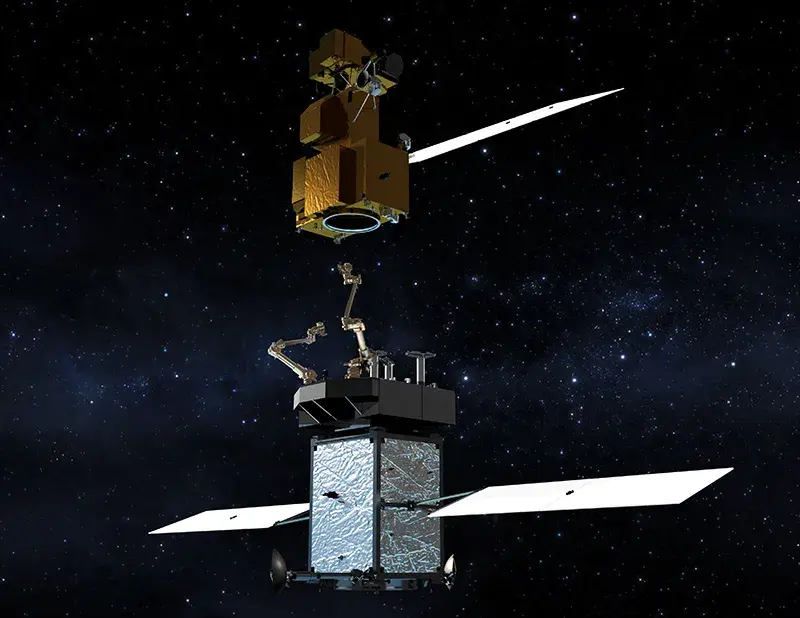Earth vs Space Robots: Key Differences and Similarities
- rayssiguieesther
- Nov 11, 2024
- 3 min read
Robots have transformed industries on Earth and are now essential in space exploration and satellite servicing. While both Earth and space robots share core features like precision and autonomy, their designs and capabilities differ to meet the demands of their environments.
Key Differences
1. Environmental Conditions
Gravity: Earth robots operate in 9.81 m/s² gravity, while space robots function in near-zero gravity. This absence of gravity allows unique manoeuvres but also requires special control algorithms. Unintended movements can lead to reactive forces to the target and push it away from its orbit by accident.
Temperature: Space robots endure extreme temperatures ranging from -65 to +125 °C in LEO. They also need to survive rapid change of temperatures, and extreme heat and cold at the same time depending on its orientation and Sun exposure. They require special materials and insulation to protect its components.

Image credit: NASA
Atmospheric Pressure: Space robots operate in a vacuum, making heat dissipation a challenge. Additional design for thermal management such as cooling systems and thermal blankets for insulation are needed.

Image credit: ESA
High intensity Light or Darkness: Space robots must handle intense sunlight and prolonged darkness. High intensity sunlight causes overexposure and image saturation. Special filters and adaptive exposure controls are used for machine vision, and light torch, infrared sensors help navigate in low-light conditions. In addition, the presence of reflective surfaces —such as metal, ice, or dust—can cause glare, further complicating machine vision tasks.
Radiation: Space robots face significant radiation levels, with lunar robots receiving 0.38 - 0.55 Sv/year and Mars robots 0.22 - 0.24 Sv/year, compared to 0.0003–0.0004 Sv/year on Earth. Radiation-hardened electronics are needed, often making robots bulkier, heavier, and more costly than Earth-based robots.
2. Structure Design and Materials
Weight: You want to make your robot as lightweight as possible to minimise launch costs (generally costing + $1 M).
Material: While Earth robots use steel, aluminium, and composites, space robots are made from titanium, radiation-hardened electronics, and specialised coatings to withstand harsh conditions. Material choice also considers safe de-integration at the end of the robot's life when re-entering Earth’s atmosphere to reduce space debris and environmental impact.
Power: Earth robots generally rely on stable power sources, while in space, robots rely on solar panels which is limited (as they are sometimes in shades for long period of times). To date, satellites are also not usually made to deliver the required power for a robot to operate autonomously. Space robots have to prioritise energy usage optimisation to maximise operation tie. For example, CANADRAM-2 can’t even lift itself on Earth gravity as they are designed with low power motors.

Image credit: ESA
3. Mobility and Navigation
Earth robots often move on wheels, tracks, or legs, and rely on GPS. In space, robots use onboard sensors and advanced algorithms for precise navigation in three-dimensional space.

4. Communication Systems
Earth robots can communicate via stable, high-bandwidth networks or cables with low latency. Space robots face communication delays - it takes 2-3 seconds to reach the ISS and 13-22 minutes to Mars. If you robot is in LEO, you have a 10 - 15 minutes every 90 - 120 minutes window to communicate with it. This makes autonomy crucial for space robots.

Image credit: Haidegger 2008
Key Similarities
Dispite the differences cited above, Earth and Space robots share fundamental aspects that drive their performance and adaptability.
1. Similarities with Nuclear and Deep-Sea Robots
Robots from nuclear and deep-sea industries face extreme operational challenges like space robots, including:
remote control needs
autonomy
latency
radiation resistance (nuclear)
specific control algorithms needed (deep sea)
darkness (deep-sea)
They share a focus on resilience, autonomy, and specialised materials to function where direct human access is impossible.

Image credit: Culham Centre for Fusion Energy, UK
2. Autonomy and Decision-Making Capabilities
Both Earth and space robots use AI and machine learning for object detection, obstacle avoidance, and decision-making to perform tasks independently.
3. Precision and Manipulation Skills
Industrial robots on Earth assemble electronics with sub-millimeter accuracy, while space robotic arms repair satellites or capture free-flying objects.
4. Safety and Redundancy
Safety is key in both environments. Earth robots include safety features for operators, while space robots use redundancy to prevent mission failure due to repair challenges.
Future Developments
Technological advancements are making Earth and space robots more interconnected. Developments in AI for Mars rovers influence autonomous vehicles on Earth, and innovations for space robots help improve Earth-based robots in extreme conditions.
As the space economy grows, robotics in space will continue to evolve, driving innovations in AI, machine learning, and materials science, transforming operations on Earth as well.



Comments